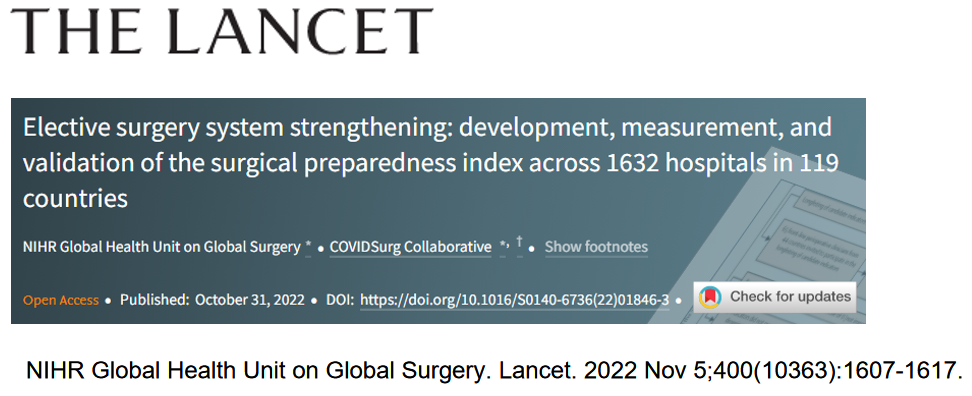2022-11-21


2015年《柳叶刀》全球外科委员会将手术和麻醉确定为整体卫生保健系统不可或缺的部分。然而,COVID-19暴露了世界各地计划手术服务的脆弱性,这在大流行恢复规划中也被忽视了。本研究旨在开发和验证一个新的指标,以支持局部选择性手术系统的加强和解决日益增长的积压。
1632家医院中有745家(45.6%)属于中等收入国家或中等收入国家。SPI平均得分为85.4 (95% CI 84.1 - 84.9), HIC(88.5[89.0 - 80.0])、MIC(88.1[88.5 - 80.1])和LIC(66.8[64.9 - 68.7])分不同,在第三阶段,1217家(74.6%)医院在COVID-19大流行期间没有维持预期的SVR,其中625家(51.4%)来自HIC, 538家(44.2%)来自MIC, 54家(4.4%)来自LIC。在混合效应模型中,SPI增加10点对应3.6% 。
SPI包含23个全球适用的指标,与不同的系统压力源相关,在次国家水平上不同,并可由一线团队收集。在COVID-19病例研究中,更高的SPI与增加的计划手术体积比相关,与国家收入状况、COVID-19负担和医院类型无关。医院应每年对其手术准备情况进行自我评估,以确定可以改进的领域,建立当地手术系统的弹性,并提高处理选择性手术积压的能力。
Abstract
Background: The 2015 Lancet Commission on global surgery identified surgery and anaesthesia as indispensable parts of holistic health-care systems. However, COVID-19 exposed the fragility of planned surgical services around the world, which have also been neglected in pandemic recovery planning. This study aimed to develop and validate a novel index to support local elective surgical system strengthening and address growing backlogs.
Methods: First, we performed an international consultation through a four-stage consensus process to develop a multidomain index for hospital-level assessment (surgical preparedness index; SPI). Second, we measured surgical preparedness across a global network of hospitals in high-income countries (HICs), middle-income countries (MICs), and low-income countries (LICs) to explore the distribution of the SPI at national, subnational, and hospital levels. Finally, using COVID-19 as an example of an external system shock, we compared hospitals' SPI to their planned surgical volume ratio (SVR; ie, operations for which the decision for surgery was made before hospital admission), calculated as the ratio of the observed surgical volume over a 1-month assessment period between June 6 and Aug 5, 2021, against the expected surgical volume based on hospital administrative data from the same period in 2019 (ie, a pre-pandemic baseline). A linear mixed-effects regression model was used to determine the effect of increasing SPI score.
Findings: In the first phase, from a longlist of 103 candidate indicators, 23 were prioritised as core indicators of elective surgical system preparedness by 69 clinicians (23 [33%] women; 46 [67%] men; 41 from HICs, 22 from MICs, and six from LICs) from 32 countries. The multidomain SPI included 11 indicators on facilities and consumables, two on staffing, two on prioritisation, and eight on systems. Hospitals were scored from 23 (least prepared) to 115 points (most prepared). In the second phase, surgical preparedness was measured in 1632 hospitals by 4714 clinicians from 119 countries. 745 (45·6%) of 1632 hospitals were in MICs or LICs. The mean SPI score was 84·5 (95% CI 84·1-84·9), which varied between HIC (88·5 [89·0-88·0]), MIC (81·8 [82·5-81·1]), and LIC (66·8 [64·9-68·7]) settings. In the third phase, 1217 (74·6%) hospitals did not maintain their expected SVR during the COVID-19 pandemic, of which 625 (51·4%) were from HIC, 538 (44·2%) from MIC, and 54 (4·4%) from LIC settings. In the mixed-effects model, a 10-point increase in SPI corresponded to a 3·6% (95% CI 3·0-4·1; p<0·0001) increase in SVR. This was consistent in HIC (4·8% [4·1-5·5]; p<0·0001), MIC (2·8 [2·0-3·7]; p<0·0001), and LIC (3·8 [1·3-6·7%]; p<0·0001) settings.
Interpretation: The SPI contains 23 indicators that are globally applicable, relevant across different system stressors, vary at a subnational level, and are collectable by front-line teams. In the case study of COVID-19, a higher SPI was associated with an increased planned surgical volume ratio independent of country income status, COVID-19 burden, and hospital type. Hospitals should perform annual self-assessment of their surgical preparedness to identify areas that can be improved, create resilience in local surgical systems, and upscale capacity to address elective surgery backlogs.
Funding: National Institute for Health Research (NIHR) Global Health Research Unit on Global Surgery, NIHR Academy, Association of Coloproctology of Great Britain and Ireland, Bowel Research UK, British Association of Surgical Oncology, British Gynaecological Cancer Society, and Medtronic.
文章连接:
www.bmj.com/content/379/bmj-2022-071380.long
百度浏览 来源 : 医微客
版权声明:本网站所有注明来源“医微客”的文字、图片和音视频资料,版权均属于医微客所有,非经授权,任何媒体、网站或个人不得转载,授权转载时须注明来源:”医微客”。本网所有转载文章系出于传递更多信息之目的,且明确注明来源和作者,转载仅作观点分享,版权归原作者所有。不希望被转载的媒体或个人可与我们联系,我们将立即进行删除处理。 本站拥有对此声明的最终解释权。




发表评论
注册或登后即可发表评论
登录注册
全部评论(0)